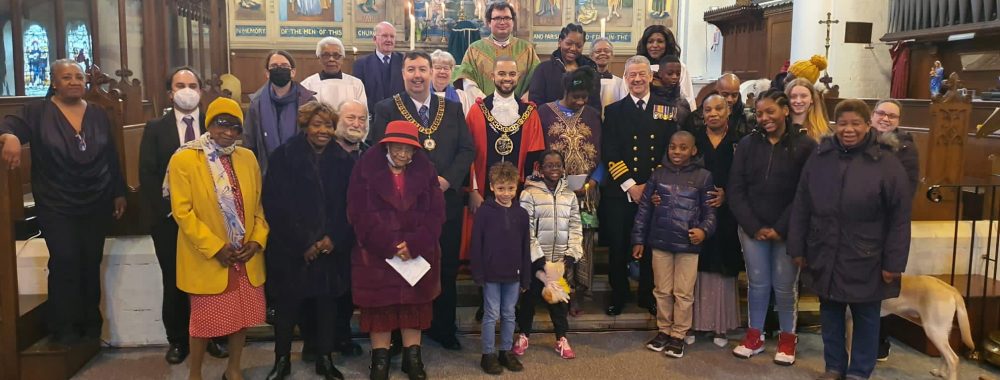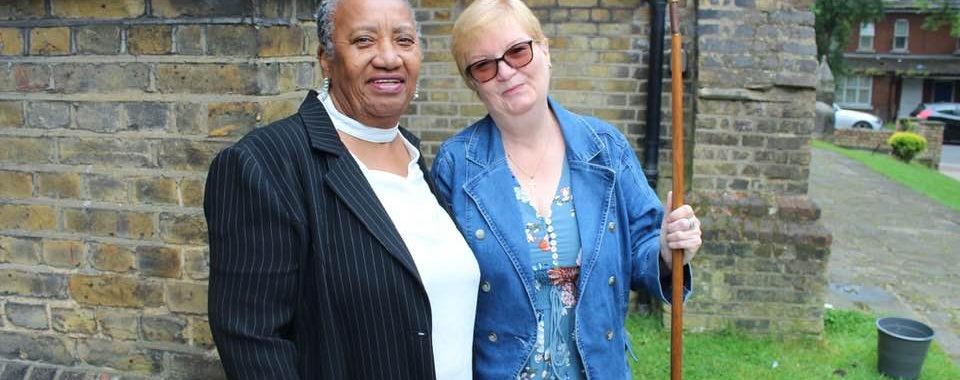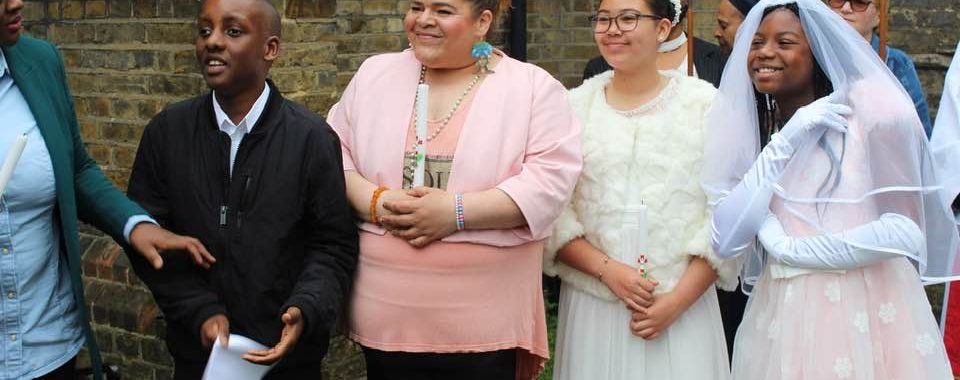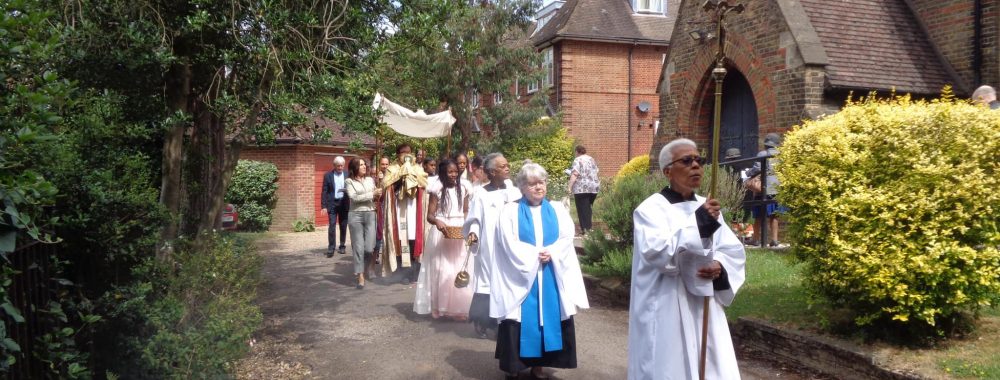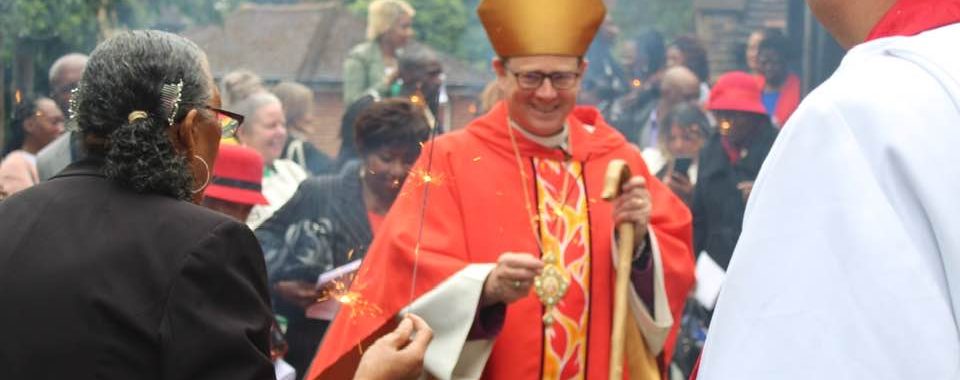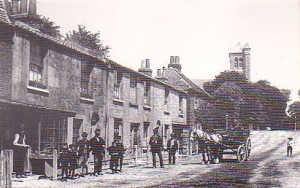Origins
The name Harringay probably has its origin in the Saxon period.It may well be derived from the name of a Saxon person, probably a local chieftan, called Hering. Heringes-hege in Old English means the enclosure of “Hering”. The earliest written form of the name was recorded as Harenhg’in about 1195.
Hornsey became a parish in or around 1300. The heavily wooded area at the time contained farms and villas, one of which was Crouch Hall, probably built in 1681 at the crossroads of what came to be known as Crouch End.
By 1808 the present Town Hall site housed the non-conformist Broadway Chapel, two cottages, an alley and the long low Lake Villa, the gable end of which faced the Broadway. In 1827 the pond by the roadside was filled in. The buildings in front of Lake Villa gradually became shops.
The 1835 Municipal Corporations Act had created 178 corporate boroughs in England and Wales. Corporations were elected directly by ratepayers, hold open council meetings and maintain audited accounts. This eventually led to the construction of town halls in industrial cities like Birmingham, Liverpool, Manchester and Leeds. Twenty years later, the Metropolitan Management Act began to change the way London was administered, creating local boards.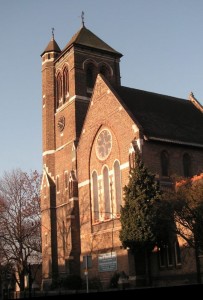
The church of HOLY INNOCENTS, on the corner of Tottenham Lane and Rokesley Avenue, was built in 1876-7 to a design by A. W. Blomfield. It was dedicated on 28 January 1887 – the year when Queen Victoria was proclaimed empress of India, Emile Berliner invented the microphone, and Thomas Edison announced the invention of his phonograph.
This was the year when the first test cricket match between England and Australia took place and the first Wimbledon.
Holy Innocents was built using yellow brick with red-brick and stone dressings in a Gothic style. It has a chancel, north chancel, and south tower surmounting an organ-chamber, and an aisled and clerestoreyed nave with south porch, at the west end the original design had two vestries (one of which is now the Lady Chapel). The original church contained 860 seats, all free, and according to local records on one Sunday in 1903 the congregations numbered 440 in the morning and 721 in the evening.
Between 1973-4 the western bay was refashioned as a hall, reducing the seating for services to around 300. In 1877 a district was assigned from the parish of Hornsey and the patronage of the living was vested in the bishop.The patron is the bishop of London.
Church life in the 1870s
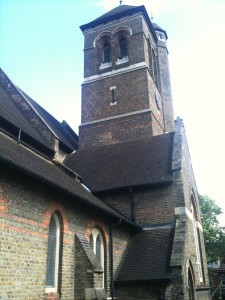 The church was dedicated on 29 January 1877 and built as the daughter church of the Hornsey Parish Church.
The church was dedicated on 29 January 1877 and built as the daughter church of the Hornsey Parish Church.
At this time the green fields of Hornsey were being transformed into Victorian terraced houses. Congregations were flourishing. By the early 20th century attendance at Holy Innocents numbered over 1,100 on a Sunday.
During this time of huge expansion, Holy Innocents was built as a mission hall – a gift from the Gamlin Family. (Later, the family would make other donations of the Lectern which carries an inscription regarding their gift.)
The mission hall was located where you see Hornsey Girls’ School today in Hornsey Vale. The purpose of it was to act as an ‘overflow’ and meet the spiritual needs of residents in that part of the parish.
As well as extra services, the mission hall provided a Sunday school and continued until the 1950s.
Various parochial activities including took place in the main church building during this time. Other activities including the uniformed organisations, a Wives’ Club, Mothers’ Union and money-raising events such as bazaars and whist drives were arranged in the Mission Hall until the 1960s when Haringey Council placed a compulsory purchase order on the entire Hornsey Vale area for major redevelopment.
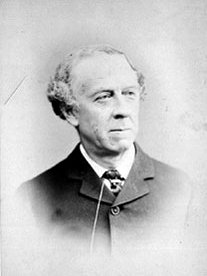 Design and Architects
Design and Architects
Holy Innocents was designed by the Victorian architect, Arthur Blomfield. Nicholas Pevsner (a leading authority on British Architecture) knew Blomfield and is reputed to have said that Holy Innocents was one of Blomfield’s less refined but more masculine styles. Visitors are always surprised by the welcoming and decorative interior after first seeing the bold and plain stark exterior.
A walk around Holy Innocents
Entering the church by the main door, visitors are drawn to look at the large stain-glassed window at the East end. This was given in memory of Peter Robinson (the founder of the famous Oxford Street store) by his widow. The window depicts scenes from the life of Christ and the large round window above it is decorated by the four archangels.
If you follow the right side of the sanctuary, there is the original organ and an altar dedicated to Our Lady. This altar is used at certain times of the year and during special masses associated with Mary, the Mother of God.
The organ near the sanctuary has two manuals and in its day, provided a good tone. There are also two war memorials. The smaller can be seen to the left of the organ and is dedicated to those of the parish who lost their lives during the Second World War.
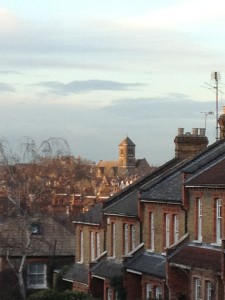 The larger of the two memorials dominates the East End wall.
The larger of the two memorials dominates the East End wall.
This screen was created in 2001 by Ursula Reines, wife of our organist, Gilbert. In this piece of fine artwork, the four apostles and scenes from the Nativity and Resurrection are depicted. Behind the main altar is a picture painted on alabaster by an unknown artist entitled “Christ in Glory”.
On the North side of the church is the Lady Chapel where mid-week services usually take place. A wooden and glass screen separates this chapel from the main church and was built to mark the 50th anniversary of the Church’s dedication.
The stained glass window behind the altar in the Lady Chapel has the themes of Faith, Hope and Charity. The wooden chairs used here, were bought in the 1950s and each seat has a name on it, in memory of relatives and friends.
Also in the Lady chapel is a statue dedicated to our Lady of Walsingham which the church has had a long association with.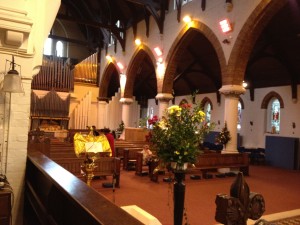
Leaving the Lady Chapel there is a small altar on the north side in memory of friends and relatives who have died. Some of the Stations of the Cross can be seen along this wall and continue on the South side wall. Stations of the Cross is a Catholic devotion particularly associated with Holy Week that reminds us of the Passion of Christ.
At the centre of the West end is the font. It was given by St Nicolas Parish Church, Great Wakering, Essex.
Following the acquisition, we discovered that the font was originally built in the same year that Holy Innocents was dedicated – 1877.
It is also hard to miss the network of organ pipes that dominate the West wall. This ambitious project was started in 2001. The Rieger-Kloss Krnov organ originating from Czechoslovakia was transported from the Humbervale Church in Toronto, Canada to Holy 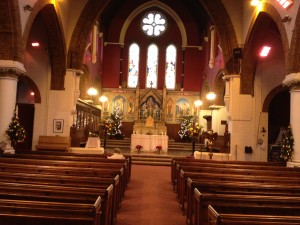 Innocents.
Innocents.
The organ was originally bought in 1964 by Mrs Dagmar Kopecki for her studio next to the house she lived in. It was then bequested to the Humbervale United Church in 1976.
Other objects of interest include a Black Madonna dedicated to the Shrine of Our Lady and a Crucifix outside, facing Tottenham Lane.
